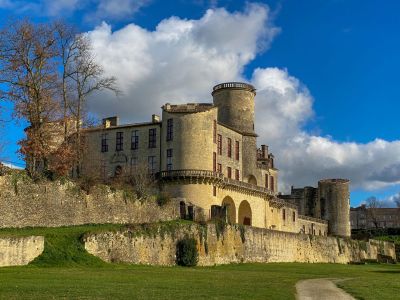Château de Duras

Discover the Château de Duras, located opposite the Hostellerie des Ducs.
It was out of anger that this monument was born. Guillaume Amanieu, Viscount of Bezaume, wanted to build a fortress on the peak dominating the Drot plain and beyond that of the Garonne...
At the foot of this eminence a town: Saint Eyrard, an important town. The Viscount of Bezaume summoned the inhabitants to climb the hillside to build “his” castle. In addition he added that they should settle around the castle which would open to welcome them in the event of an invasion….
1137 : the first major date in the history of Duras, we are in July, we celebrate the wedding of Eleanor of Aquitaine and the future king of France. During the festive meal, Guillaume announces that his “castrum” has been built…. This is the first time that archives mention the existence of the “castrum” of Duras.
And then a great black veil falls over the history of the castle, the Bezaume family disappears!
1308 : the castle returns by inheritance to the Goth family.
One of the members whose name has remained in history is Bertrand de Goth who became pope, the first French pope under the name of Clement V. And Clement V finances (with the money of the Templars perhaps) the reconstruction of the castle and the construction of the Villandraut castle… These two castles are part of the “Clementine” castles. It was his niece Marquesie de Goth who received the castle as an appanage. By marrying Arnaud de Durfort, Marquésie would give birth to a lineage which would own the castle until the middle of the 19th century.
For 3 centuries Aquitaine remained an English possession, all because of the remarriage of Eleanor of Aquitaine with Henry Plantagenet who became king of England. The one who was twice queen brought her blonde Aquitaine as a dowry to her new homeland. And this is how this province will be the subject of conflicts between the two countries.
Duras is located in Guyenne, that is to say in English Aquitaine. We will always support here the cause of the “leopards”, the English cause, we will always fight against the Kingdom of Lys (kingdom of France). This led to the town of Duras being taken by du Guesclin in 1377. The town was sacked and the castle was damaged.
July 17, 1453 : the battle of Castillon marks France's victory, Aquitaine becomes French again.
Is this the end of Duras and the Durfort family?
Nay! The country will engage in a new conflict, that between Catholics and members of the Reformed religion. And it's quite logical since Marguerite d'Angoulême, the sister of King François I of France, resides in Nérac. This last fine scholar received many personalities including certain members of the Reformed church, she received Clément Marot, Théodore de Bèze and even Calvin (on his way to Geneva). Marguerite d'Angoulême married Henri d'Albret for the second time. Their daughter Jeanne d'Albret will be the last queen of Navarre, her son Henri III of Navarre is better known under the name Henri IV.
Duras is located in the heart of this region where sacrifices are made to the Protestant religion. And Duras will play the Protestant card. So much so that Jeanne d’Albret will be welcomed at the castle…. Where she will prepare the accession of her son to the throne of France.
Barely had his marriage to Queen Margot been celebrated, when Henri had to retreat to Nérac... The massacre of Saint Barthélemy forced him to leave Paris! For ten years Nérac will become a royal city!
1589 : Henry IV is enthroned king of France. He leaves the southwest forever.
As soon as he came to power, he promulgated the Edict of Nantes.
There is peace in the land of Duras... Well almost because Louis XIII will - throughout the period of his reign - fight against the Protestants.
Louis XIV arrives. The Sun King will seek to “attract” these Protestant noble families. This is why he will suggest that Durfort’s family convert to Catholicism…. The Durforts will very skillfully get out of this dilemma. Jacques de Durfort will comply with royal demands... very skillfully. He will explain that he is going – with his family – to listen to two sermons, one given by a Protestant preacher, the other delivered by a Catholic priest. The preacher of the Reformed religion was from La Sauvetat du Dropt, his name was Jean Claude, it was Bossuet who took the pulpit for the Catholics….
And Durfort’s family converted to Catholicism!
Jacques Henri became Duke and peer of France, his brother Louis left for Ireland, he became viceroy of the island and war professor of Churchill's great-grandfather. Louis Duke of Feversham took English nationality.
The Durfort family will now live in Versailles!
Jacques Henri will transform the dark fortress into a pleasure castle, two towers will be demolished, the main courtyard will be built and superb stables will be built in the town, the orangery will rise below the castle.
The Durfort family will hardly come to the castle anymore. Monsieur de Durfort will be appointed ambassador to Austria.
This friend of Choiseul had been sent on a mission by the latter to negotiate the marriage of Archduchess Antonia with the future Louis XVI.
1789: the revolution
Emmanuel Félicité will leave the castle. It will be the same for his son Amédée Malo. The latter will meet in London a young girl from Martinique Claire de Kersaint. The young people will get married in London at midnight in a stable transformed into a chapel.
The Duke and Duchess will return to Duras . They will find their castle in a very poor state…
Lakanal had given the order to truncate the towers: the stones should have been used to build locks to make the Drot navigable.
They will buy the castle.
Claire de Kersaint will want to get closer to Paris. The duke will offer him the magical castle of Ussé. Then, the Durforts will settle permanently in Paris. Claire de Kersaint will write a number of books.
In the 19th century, she was a woman writer recognized in the literary spheres. His manuscripts are in the National Library.
The Durfort family leaves the Duras castle for good.
And then a long period will begin where, little by little, at the discretion of its owners, the castle will experience a “descent into hell”.
Canon Aureille, who owned it, would have wanted to transform it into a church: a pharaonic construction site... In the cellar of the castle, the pillars of a chapel remained for several years. They are missing today.
A certain Victor Hugo Duras, a strange character, acquired it just before the war. When he died, his descendants had to be found, which took some time.
Then the castle was purchased successively by 2 SARLs who never transformed it as they had wished. The castle was disintegrating little by little, it had become a ruin which stood tall and which still stood proudly on its hillside.
A small group of Duraquois set out to save him. This is why when the castle was put up for auction, it was just 50 years ago. The municipality became the buyer.
March 20, 1969 : Second major date in the history of the ducal castle, the date of its resurrection!
Since then, numerous restoration plans have been put in place involving the State, the region, the department and the municipality.
Today the castle has regained its soul.





